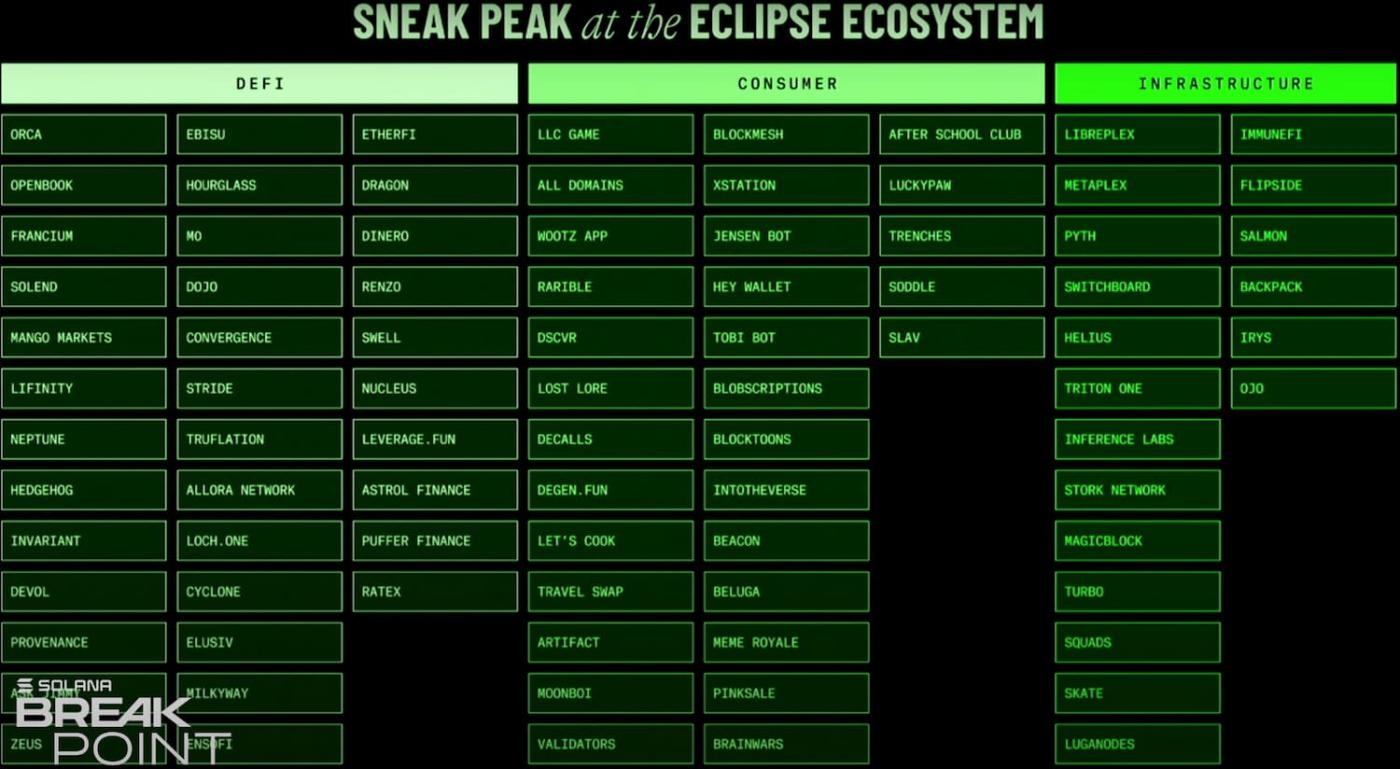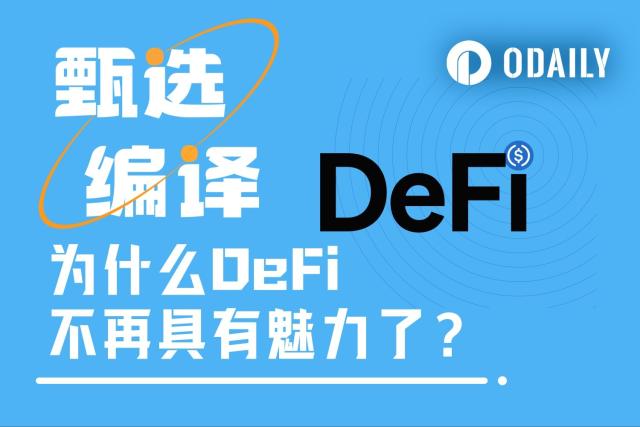The Eclipse mainnet is about to be launched, how is the ecosystem development? How should we layout the airdrop opportunities?
Author: Karen, Foresight News
Last week, Eclipse officially launched its official bridge, supporting the deposit of ETH from Ethereum to the Eclipse network. At the same time, the project will launch its public mainnet in the coming weeks.
Although Eclipse has been embroiled in some controversies due to the undisclosed private transactions between Niraj Pant, a former partner of Polychain, and Neel Somani, the former CEO of Eclipse Labs, its popularity remains undiminished.
As an Ethereum-based SVM (Solana Virtual Machine) L2 project, Eclipse utilizes Celestia's data availability and verifiability, as well as RISC ZERO's ZK fraud proof technology, to bridge Ethereum and Solana, combining the high performance and scalability of SVM with the security properties of Ethereum. Furthermore, Eclipse accepts ETH as the Gas payment method, which helps it easily acquire liquidity and the network effects of Ethereum.
The author also noticed that Eclipse CEO Vijay Chetty revealed at Solana Breakpoint 2024 that Eclipse has become one of the largest data users of Celestia. Currently, Eclipse's ecosystem is mainly focused on three vertical areas: DeFi, consumer, and infrastructure, and plans to launch its public mainnet in October.

Source: Screenshot of Eclipse CEO Vijay Chetty's speech at Solana Breakpoint 2024 conference
When discussing the future development of Eclipse, Vijay Chetty shared the project's roadmap, including building a trustless L2, achieving trustless deposits and chain expansion, introducing fraud proofs and forced inclusion, developing a sequencer rotation protocol, and a governance mechanism. He also mentioned that Eclipse's long-term vision is to drive high-throughput DeFi and consumer applications on-chain, and plans to introduce Firedancer.
Note: Firedancer is designed to eliminate single points of failure and enhance the overall resilience and robustness of the network. Unlike the original Rust-based validators, Firedancer is written in C, which significantly reduces the impact of potential vulnerabilities on the entire network, adding another strong defense for Solana's security. Recommended reading: What is the much-anticipated Firedancer at Breakpoint?
It is worth mentioning that Eclipse has also created a unified restaking token "tETH", which supports depositing LRT tokens to earn tETH and participate in more Eclipse ecosystem DeFi opportunities, as well as earn more rewards. In Vijay Chetty's eyes, Eclipse will become the LRTfi home. URT currently supports ETH, and will later support SOL.
Eclipse's total funding has reached $65 million, and its ecosystem development has been closely watched since the mainnet was opened to Builders at the end of July. It is worth noting that multiple mainstream Solana ecosystem projects such as Orca, Save, Mango, and Backpack will support the Eclipse network, but native Eclipse projects are currently relatively scarce. Let's explore the Eclipse ecosystem and interaction methods together.
DeFi
Orca: Solana's token swap and liquidity platform, will launch on Eclipse.
OpenBook: Solana's DeFi hub, will launch on Eclipse.
Francium: Solana's mining and lending platform.
Save (formerly Solend): Solana's lending platform.
Mango Markets: Solana's DEX Mango Markets.
Lifinity: Solana's DEX, using oracles to update the prices provided on the DEX.
Neptune Protocol: Eclipse's native stablecoin project, allowing users to deposit various collateral types (TIA, stTIA, wETH, stETH, SOL, JitoSOL, mSOL, stDYDX, and RETH) to create a Neptune vault, enabling them to obtain loans from Neptune. Loans are issued in the platform's native stablecoin USDN. Neptune Protocol will also issue the protocol token NPT to reward users who provide liquidity to the system. Additionally, those who stake NPT tokens will receive proportional staking rewards.
Hedgehog: Solana's prediction market.
Invariant: Solana's AMM DEX.
Zeus Network: Solana's permissionless communication layer.
Hourglass: Allows token staking communities to access partner tokens.
Ebisu: Allows users to borrow USD-denominated credit by using LRT (liquidity restaking tokens) as collateral. ebUSD is Ebisu's overcollateralized stablecoin, allowing users to earn rewards from EigenLayer AVS and Ethereum staking rewards. Ebisu has launched Ebisu Money public testnet on Omni Omega.
Stride: Celestia and Cosmos ecosystem's liquidity staking and modular cross-chain project.
Allora: Decentralized AI network, previously announced integration with Eclipse, which will allow developers to directly access advanced AI models using Allora's infrastructure.
Loch: Can view unrealized and realized gains for each token and the entire portfolio, and also allows on-chain copy trading, currently in invite-only stage.
EnsoFi: Fixed-rate and lending protocol on Solana and Sui, has already launched on the Eclipse testnet.
ether.fi: Liquidity restaking project on Ethereum.
Dinero: Yield protocol on Ethereum, including ETH liquidity staking tokens (pxETH, benefiting from Dinero validator's ETH staking rewards), collateral-backed stablecoin pxUSD, and permissionless RPC.
Renzo Protocol: Liquidity restaking protocol.
Swell: Liquidity restaking platform.
Nucleus: Yield protocol, enhancing network users' yields by directly partnering with restaking platforms, and also earning lending returns using Ion Protocol. Nucleus will soon support tETH on Eclipse.
Leverage.fun: DeFi platform focused on risk management, launched by the spot, perpetual, and options P2P market Convergence.
Astrol: Native lending protocol on Eclipse. Its first product is Astrolend, a decentralized overcollateralized lending protocol.
Puffer Finance: LSD protocol.
RateX: Leveraged yield trading protocol, previously won the MCM region at the Solana 2024 Renaissance hackathon hosted by the Solana ecosystem accelerator Colosseum. RateX has launched on Solana.
DeCalls: Price prediction game. DeCalls will launch on Eclipse.
Sharp Trade: Solana's prediction and options platform, has launched on Eclipse.
Non-Fungible Token (NFT)
Rarible: NFT marketplace.
Scope: Eclipse's native NFT Launchpad powered by Rarible, supporting the creation, launching, and minting of NFTs. Over the next 4 months, all platform fees on Scope will be used for the Eclipse Creator Fund to support artists and their creative work on Eclipse.
Validators: An NFT series on Eclipse, also providing the Eclipse Bridge. Validators' Blip feature supports sending messages to wallets on Eclipse.
After School Club: NFT series and student community on Eclipse.
MEME
Let's Cook: Launchpad and MemeFi platform. The platform's on-chain community rating system Hype is inspired by Reddit's voting system. Let's Cook has also launched the on-chain credit system Sauce, where users can earn Sauce through activities like rating and executing market orders. Sauce will be used to distribute COOK tokens in the future.
XSTATION: Allows direct trading of memecoins and other on-chain activities on the X, Web3 social network.
Moon Coin: Claiming to be the first coin on the Eclipse Network. Currently, $Moon can be earned through invitations, spinning wheels, check-ins, and other activities in the Telegram mini-program. The Moon Coin Twitter account has been followed by the Official Twitter of Backpack.
https://x.com/MooncoinSVM/status/1833818865912185060
AI
Beacon Protocol: The Beacon Protocol envisions that in the future, when AI uses our data, we will all be compensated. The Beacon Data Hub is about to include the automotive IoT platform DIMO and the decentralized AI network Allora. The Beacon Protocol stack includes Zama FHE, Lit Protocol MPC, and RISC Zero ZK, for cutting-edge privacy and computation in AI.
https://x.com/BeaconProtocol
WootzApp: Solving the AI training data problem, a better Web extension than native applications. The WootzApp app store code is in the testing phase.
https://x.com/WootzApp
BlockMesh Network: An open-source secure network for ethical AI supervision, previously awarded at the Solana Renaissance hackathon hosted by the Solana ecosystem accelerator Colosseum.
https://x.com/blockmesh_xyz
Infrastructure
Backpack: Solana ecosystem wallet and trading platform Backpack. The Official Twitter of Eclipse and Backpack interact frequently.
https://x.com/Backpack
Hyperlane: Cross-chain messaging protocol, already supporting Eclipse and Solana.
https://x.com/hyperlane
Metaplex: Providing a Digital Asset Standard (DAS) that supports tokens and Non-Fungible Tokens on the Solana blockchain.
https://x.com/metaplex
Pyth Network: Oracle. Pyth has launched Pyth Price Feeds on Eclipse.
https://x.com/PythNetwork
Switchboard: Oracle network.
https://x.com/switchboardxyz
Stork: Oracle provider.
https://x.com/StorkOracle
Helius: Solana ecosystem RPC, API, data, private nodes, and developer support.
https://x.com/heliuslabs
Triton One: Providing RPC for blockchains like Solana and Sui.
https://x.com/triton_one
MagicBlock: High-performance engine for on-chain games and applications.
https://x.com/magicblock
Squads: Multi-signature management tool for the Solana ecosystem.
https://x.com/SquadsProtocol
Skate: Leveraging intent-driven mechanisms to facilitate cross-chain interactions, enabling global applications to run with consistent state across various technology frameworks.
https://x.com/skate_chain
Luganodes: Staking infrastructure.
Flipside: On-chain data platform.
https://x.com/flipsidecrypto
Salmon: Open-source wallet.
https://x.com/salmonwallet
Hey Wallet: Social wallet and trading assistant.
https://x.com/hey_wallet
Others
Arcium: Supercomputer for the hyper-encrypted internet, supporting secure execution of any computation on fully encrypted data.
https://x.com/ArciumHQ
AllDomains: Web3 domain platform.
https://x.com/AllDomains_
Blobscriptions: Expanding inscription functionality across multiple ecosystems, will integrate with the Eclipse network, allowing users to mint inscriptions on Eclipse using their intuitive tools.
https://x.com/blobscriptions
IntoTheVerse: Building a mobile game metaverse.
https://x.com/IntoTheVerse_
LuckyPaw: Asset issuance layer.
https://x.com/LuckyPawFun
Soddle: Earn rewards by guessing your favorite crypto personalities using prompts, tweets, and emojis.
https://x.com/soddle_
How to Interact?
1. Add the Eclipse network in the Backpack plugin wallet.
https://backpack.app/
2. Cross-chain ETH:
Official cross-chain bridge: https://bridge.eclipse.xyz/
Hyperlane cross-chain bridge: https://www.usenexus.org/
3. Mint "Path of Discovery" Non-Fungible Token (Eclipse cross-chain bridge commemorative NFT, minting ends on October 24):
https://scopenft.xyz/
4. Trade:
- https://www.validators.wtf/ (over-the-counter purchase of related NFT series or cross-chain);
- https://www.validators.wtf/blip (send messages to wallets on Eclipse);
- https://chromewebstore.google.com/detail/blockmesh-network/obfhoiefijlolgdmphcekifedagnkfjp (earn points on BlockMesh);
- https://eclipse.sharptrade.fi/ (interact with Sharp Trade);
- https://eclipse.lifinity.io/pools (swap or provide liquidity on Lifinity);
- https://rarible.com/Anticipation-OE/items (Open Edition NFT previously launched by Eclipse on Ethereum to celebrate the solar eclipse, which will be able to cross-chain when the Eclipse mainnet is launched).
References:
https://www.youtube.com/watch?v=tyiuVT4LKQE
https://x.com/0x_xifeng/status/1839675433748664500





